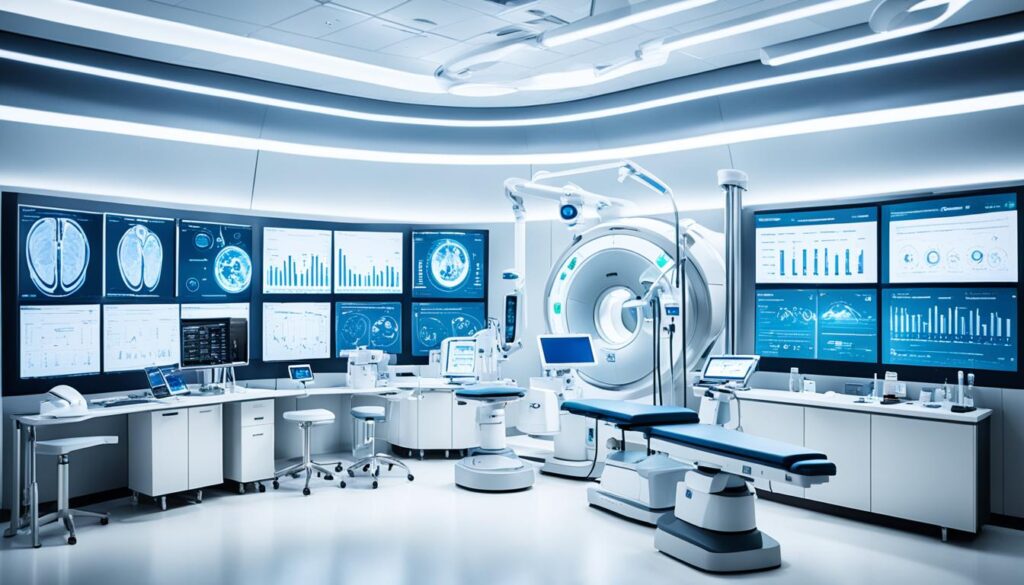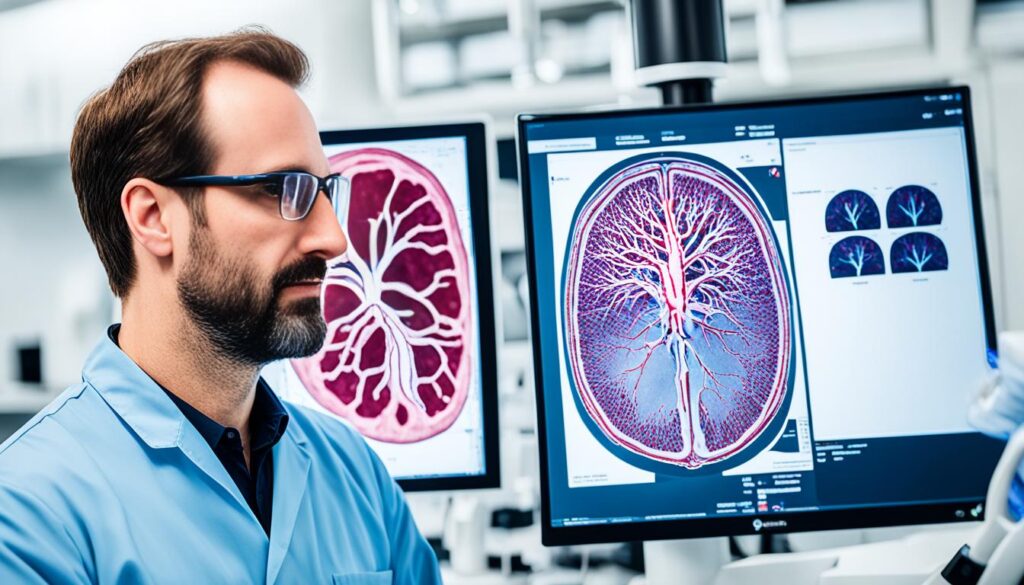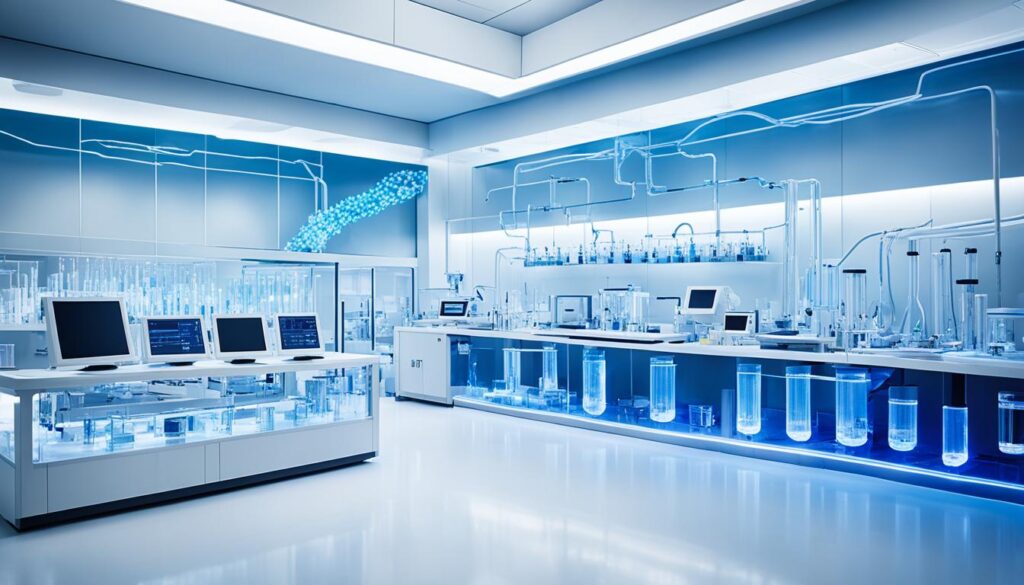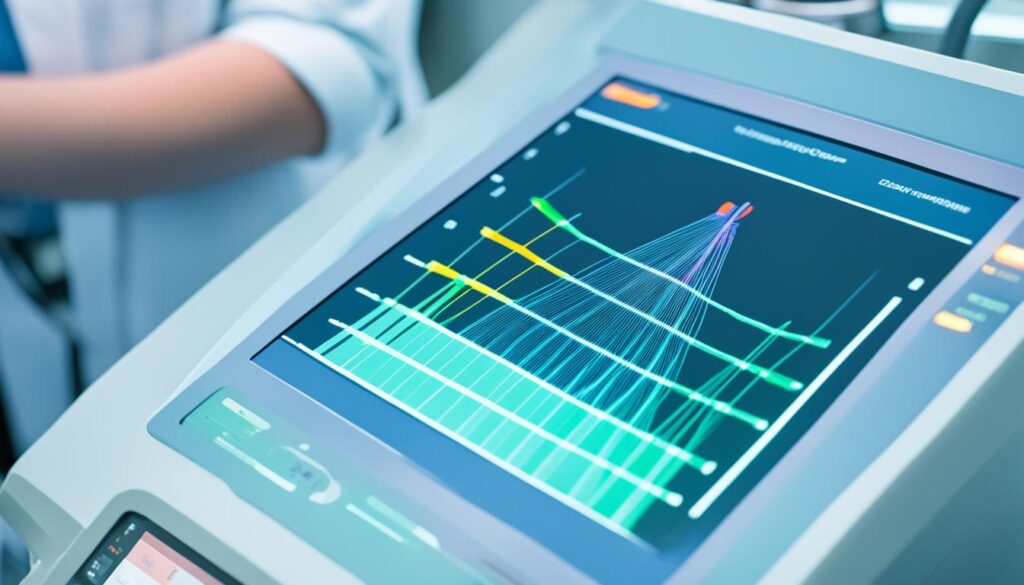Medical science is vast and ever-changing. It includes areas like medical imaging and genomic medicine. The field integrates health information technology and point-of-care diagnostics. These changes have made detecting and managing health conditions more effective. This article looks at how medical research methodologies and technological innovations are evolving diagnostic techniques for the better.
The field of medical science covers many aspects. It deals with anatomy, physiology, pathology, and more. Along the way, there have been key discoveries and advancements. These have changed how medical professionals diagnose and treat patients. For instance, the creation of X-rays, MRIs, genomic medicine, and personalized treatments.
Our understanding of medical science is always growing. Focus is now heavy on improving diagnostic techniques. This piece will show how the field is moving forward. It will discuss the major disciplines in medical science and the advancements in medical technology. These advancements aim to find diseases earlier and more accurately. We’ll also look at ethical issues in medical practice, public health and medical science implications, and what the future might hold for healthcare.
Key Takeaways
- Medical science spans many disciplines, from anatomy to pathology and beyond.
- Technological advancements, like medical imaging and genomic medicine, are changing how we diagnose diseases.
- Enhancing diagnostic techniques is a major goal in medical science’s development.
- The use of new technologies and methods brings up important ethical and regulatory questions.
- The future of medical science brings hope for better diagnostic methods and outcomes for patients.
Overview of Medical Science and Diagnostics
Medical science studies the human body, how it works, and why diseases happen. It looks at many areas such as basic science, seeing patients, and working on public health. The definition and scope of medical science are broad. Medical workers and researchers try to learn more about our bodies. They also find better ways to check and treat many health problems.
Also Read : Which Types Of Loans Are Best For Small Businesses?
Importance of Accurate and Timely Diagnosis
Getting the diagnosis right and quickly is key to helping patients. Finding diseases early can mean better chances for a patient. But figuring out what’s wrong isn’t always easy. Doctors face many hurdles to make sure each patient gets the best care.
Challenges in the Diagnostic Process
There are several challenges when it comes to diagnosing. More data and patient problems make things harder. Also, doctors don’t have a lot of time and their minds can only hold so much info. Advanced technology and research methods help tackle these issues. Teamwork, focusing on the patient, and using these new tools together are crucial. In fact, medical professionals and clinical trials are very important. They keep medical science moving forward and make diagnostics better.
The Diagnostic Process
The diagnostic process is quite complex. It is a step-by-step journey that includes working closely with the patient. Healthcare providers, patients, and their families work together. They gather information and think through the best course of action.
Important steps include talking to the patient to learn their history and doing a physical exam. Tests and consultations with other doctors follow. The goal is to come up with the best possible explanation of what’s going on. This process can take some time as the care team works through the details.
Also Read : Car Loan: What Are The Best Options For First Time Buyers?
Patient-Centered and Collaborative Approach
Talking and listening are key to a good diagnostic process. It’s important for the care team to understand the patient’s unique needs.
This approach helps doctors work better with the time and information they have. It’s a way to avoid common mistakes and provide the best possible care.
Information Gathering and Clinical Reasoning
Diagnosing a patient means putting together many pieces of information. This includes the patient’s history, how they feel, and test results. It’s like solving a puzzle to find the right answer.
This process is very important. It helps ensure the patient gets the correct diagnosis as quickly as possible. This leads to the best outcomes for the patient.
Role of Diagnostic Uncertainty and Time
Understanding that not everything is clear from the start is vital. Doctors have to work with what they know, considering the patient’s condition and the available data.
Even with the challenges, doctors play a significant role in healthcare. Their dedication, plus the use of new methods like clinical trials, keep improving patient care.
Also Read : Undergraduate Scholarship: How Do You Prepare For Scholarship?
Health Information Technology and Diagnostics

Health information technology (health IT) is key in the diagnostic process. It helps by gathering patient information and sharing data between healthcare workers.
Good health IT can make diagnosing better by giving quick access to info. It also helps the diagnostic team talk better and make decisions. Yet, bad health IT can lead to more mistakes. It does this by making work harder, causing more stress, and leaving out key info.
Also Read : How Can I Apply Scholarships For MCA?
Potential Benefits of Health IT for Diagnostics
Using health IT tools and tech can bring many advantages for diagnosing patients, such as:
- Accessing patient info and medical history better, which leads to smarter decisions
- Helping the diagnostic team talk and work better together for the patient’s benefit
- Providing automated analysis tools to find important patterns in data for more accurate diagnoses
- Making work smoother for healthcare workers, letting them help patients more directly
Design Considerations for Health IT in Diagnostics
Creating great health IT tools for diagnosing needs to follow some design rules, like:
- Making sure the tech is easy and quick to use, so healthcare workers can get the hang of it fast
- Adding tools that collect and study important patient data on the spot
- Matching the tech with current ways healthcare teams make decisions and work
- Helping info flow easily between patients and their clinicians or healthcare groups
Interoperability and Information Exchange
Having health IT systems working together and sharing info well is very important. This needs teamwork between tech makers, rule-makers, and the people who actually use the tech. Together, they aim to create tools that:
- Let patient data move safely between different parts of the healthcare system
- Make sure important diagnostic info gets to the right people on time
- Give patients the chance to join in by letting them see and share their health information
By keeping these goals in mind and encouraging systems to work together, health IT can make diagnosing better for medical teams and patients alike.
Also Read : Emergency Loans: How Can You Get Quick Financial Assistance?
Advancements in Medical Imaging and Diagnostics

Medical imaging has come a long way. X-rays, CT scans, MRI, and ultrasound have all seen big improvements. These changes have made diagnosing and watching health conditions better. They help find diseases earlier, locate problems more precisely, and track how well treatments are working.
The field of medical technology is always moving forward. New tools and the use of smart computers are making it easier for healthcare professionals to spot issues. By using these advanced methods, doctors and experts can give diagnoses faster and more accurately in every medical area.
| Imaging Technology | Key Advancements | Clinical Applications |
|---|---|---|
| X-Ray | Digital imaging, increased resolution, reduced radiation exposure | Bone and joint imaging, chest and abdominal examinations |
| CT Scan | Faster scan times, improved image quality, reduced radiation dose | Evaluation of internal organs, detection of cancers and vascular diseases |
| MRI | Higher magnetic field strengths, faster acquisition times, advanced contrast agents | Detailed imaging of soft tissues, brain and nervous system, musculoskeletal conditions |
| Ultrasound | Portable and handheld devices, improved image resolution, Doppler capabilities | Real-time evaluation of organs, fetal monitoring, and vascular assessments |
Medical professionals play a key role in using these new imaging tools well. They put them into practice in a way that helps patients the most. Clinical trials are very important for testing how good these new tools are. They make sure they really work and help people.
Genomics and Molecular Diagnostics

Improvements in genomics and molecular diagnostics have changed medicine. Now, doctors can offer very specific treatments. Next-generation sequencing (NGS) makes genetic testing faster and cheaper. This lets doctors find genetic issues linked to different health problems.
Next-Generation Sequencing
NGS is quickly getting better. Now, there are tests that look at specific genes to diagnose better. Doctors use these tests to pick treatments based on what your genes say. This is the start of personalized medicine, where treatments fit you perfectly.
Genetic Testing and Personalized Medicine
Using genetics is changing how doctors treat people. Now, treatment matches your own genetic makeup. This is a big step toward making sure treatments work well for everyone. Doctors are getting better at using genetic tools, pushing healthcare forward.
Biomarkers and Point-of-Care Diagnostics
Biomarkers are special molecules that show us if a disease is present and how bad it might be. These days, knowing and measuring these biomarkers is super important in medical tests. Thanks to new point-of-care testing tools, like portable devices, we can check biomarkers quickly and accurately. We don’t have to do it only in labs anymore.
Wearable Devices and Continuous Monitoring
Another big change is the use of wearable devices that keep checking our health all the time. They track things like our heart rate and can warn us early if something’s wrong. This new way of using biomarkers is a game-changer for stopping diseases before they get bad.
Diagnostic Tests for Resource-Limited Settings
Making diagnostic tests that are cheap and easy to use can help a lot of people get better access to healthcare, even if resources are limited. This is true not only in the U.S. but all around the world. It’s all because of the teamwork and hard work of medical professionals. They are making big steps in solving global health issues and moving medical science forward.
Medical Science and Public Health

Medical science is crucial for dealing with health issues. Diagnostic methods are key for preventing and managing diseases. They help in spoting diseases, which lets healthcare workers stop them from spreading.
Role of Diagnostics in Infectious Disease Control
Medical science shines in stopping infectious diseases. Quick and accurate tests are vital. They help doctors find what’s causing a disease fast. Then, they can use the right steps to keep it from spreading.
This has been very important during the COVID-19 pandemic. Testing people quickly has helped keep COVID-19 from spreading.
Preventive Medicine and Early Detection
Using advanced diagnostic tools in health screenings can make a big difference. They help find diseases early. This is really helpful in fighting diseases like cancer and heart problems.
Medical science is always improving. Using the newest tools in health efforts helps everyone stay healthy. This is key in making the world a healthier place.
Ethical and Regulatory Considerations
Medical science is moving fast, especially in diagnostics. This has led to big ethical and regulatory considerations . Taking, keeping, and using patient data from tests, like genetic details, brings up privacy and data protection issues. People in health care, research, and policy must think hard. They need to see how to bring the good of these new tools while still keeping private stuff safe.
Privacy and Data Protection
Today’s diagnostic methods are really good at finding out lots about patients. This makes keeping privacy and data protection very important. Those in health care, who make the rules, and policy makers need to work together. They should make strong plans to use patient data in the right way. This should help move medical science and healthcare policies forward.
Access and Affordability of Diagnostic Tests
Getting, and being able to afford, tests in places with few resources is a big deal. Health care workers, policy makers, and the science community need to focus on this. Making sure everyone can get tests and making them cheap is important. It helps everyone be healthier and smooths out the differences in care. Creating tests that are not expensive and easy to take everywhere can change things a lot. These approaches help with big issues in global health.
Future Prospects and Innovations
Medical science is moving ahead fast, bringing new advancements. The use of artificial intelligence (AI) and machine learning (ML) in diagnostics is growing. These technologies help spot patterns in data and diagnosis better and faster.
Artificial Intelligence and Machine Learning
AI and ML offer a lot for medical diagnostics in the coming days. They can sift through huge amounts of data from patient records and tests. This analysis helps find hidden clues about diseases. It makes diagnosing more accurate, which is great news for patients.
Integrating Diagnostics and Therapeutics
There’s also a push to link how we diagnose with how we treat. By blending diagnostics and treatments, care can get more personal and effective. This way, doctors can choose the best treatment and keep track of how well it works. They can also tweak the plan as needed, making sure patients get the best care.
Medical science is always looking to do better for people. The future seems bright with these new methods. The progress in medical Technology and healthcare innovation is key. It will change how we catch, handle, and deal with diseases. This is all for better healthcare for everyone.
Also Read : Breaking Barriers In Medical Research: A Journey Of Discovery And Hope
Conclusion
Medical science has really advanced in how it diagnoses health problems. This shift has made a big difference in how doctors spot, handle, and cure various illnesses. Thanks to new medical tools and technology, doctors can find problems earlier and more accurately. This has helped people get better treatment that fits them personally.
But, these steps forward in diagnosing health issues come with big questions about privacy and fair access to healthcare technology. As science keeps moving forward, we see hope in things like using computer brains (artificial intelligence) and getting closer to cures. The work of healthcare workers, researchers, and rule makers is key to these improvements. They all aim to make patient care and general health better.
The part medical pros and clinical trials play in medical growth is huge. They are very important in introducing new ideas and possibilities in medical science. Thanks to their hard work, the medical field continually changes for the better. This brings good life changes for many people.
FAQs
What is the definition and scope of medical science?
Medical science studies the human body, disease, and how to treat it. It looks at both research and how to help patients. This field includes basic research, seeing patients, and working to prevent diseases.
Why is accurate and timely diagnosis important in medical science?
Getting the right diagnosis quickly is key to treating patients well. But, diagnosing can be hard because there’s a lot to know. For doctors, it’s tough to keep up with new info and treat patients with more than one illness. There’s also not a lot of time to figure it all out.
What are the key challenges in the diagnostic process?
Issue in diagnosing range from needing more time to think to making mistakes in how we think. It’s also about talking well with everyone involved, like other doctors, patients, and their families.
How does a patient-centered and collaborative approach improve the diagnostic process?
Putting the patient first and working together helps solve diagnosis problems. Doctors, patients, and families share info and make plans together. Listening and talking openly are vital to this.
What role does health information technology play in the diagnostic process?
Health technology is very important in making diagnoses. It keeps patient info safe and helps doctors make decisions. Tools need to be easy to use and should fit how doctors work.
How have advancements in medical imaging revolutionized diagnostics?
New ways of looking inside people have changed how we find and treat diseases. From simpler tools like X-rays to more complex ones like MRIs, these help doctors act faster and more accurately. Training doctors well in these tools is also a big help.
What is the role of genomics and molecular diagnostics in transforming the field of medicine?
Intelligent science has made medicine more personal. We now look at our genes to see what treatments fit us best. This is called precision medicine, making our care just right for us.
How are biomarkers and point-of-care diagnostics impacting healthcare?
Finding signs early and easily has changed how we prevent and treat diseases. This is great for places where it’s hard to see a doctor. It means everyone might get care faster and easier.
What is the role of medical science in addressing public health challenges?
Medical science is key in making us all healthier. Good testing helps stop diseases from spreading. It also helps us plan how to keep healthy.
What are the ethical and regulatory considerations in the advancement of medical diagnostics?
As testing gets better, we need to think more about privacy and fairness. It’s important that everyone can use new tests safely and fairly. Doctors and leaders work to make sure of this.
What are the future prospects and innovations in medical science and diagnostics?
New tech, like AI, is making tests and care better. It helps doctors learn more and make care perfect for each of us. This means we might all get healthier care very soon.
